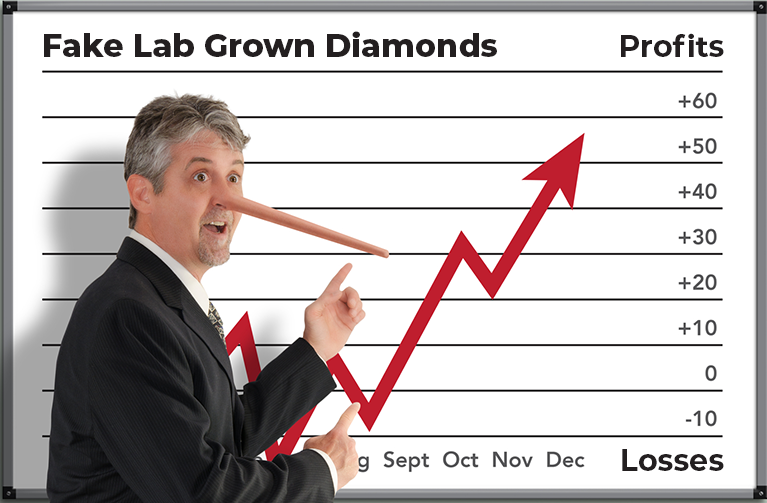In the market for diamond jewelry? Be careful where you shop! In recent years, with interest in diamond jewelry stronger than ever, some jewelers have jumped on the synthetic diamond bandwagon. What does that mean for consumers? It means shoppers have to be more vigilant than ever when shopping for these precious gemstones. Shopping for jewelry, especially diamond jewelry, should always involve research to compare cut, color, clarity, and carat weight. These days, you also have to worry about whether sketchy jewelers sell “diamonds” without disclosing that the sparklers aren’t what buyers think they are.
The Lab Created Diamond Deception
When you think about a diamond, you think about a natural stone formed in the earth over millions of years, shimmering in darkness until it is mined, then carefully faceted by expert jewelers to capture its unique one-of-a-kind brilliance. The aura surrounding diamonds is due partly to this mystical elusiveness and rarity. You can almost imagine earth’s forces, time, and artistry combining to create a diamond. It is what makes a diamond so special.
But some so-called diamonds didn’t come from mines. That special aura surrounding an earth-mined diamond isn’t there with a synthetic or manufactured diamond. These created diamonds were grown in a laboratory somewhere over just a few weeks. They aren’t natural; they aren’t unique. In fact, they are mass-produced to meet the increasing demand for sparkling gemstones that are more affordable for people looking for something close to real but with a lower price tag.
Selling diamonds that are grown in a lab to unsuspecting customers looking for an ages-old, natural stone to represent “forever” in an engagement ring is a practice that is increasing as jewelry stores seeks more significant profits. The argument goes that the diamond is still a diamond because it is chemically and structurally identical to an earth-grown diamond. But that’s where the resemblance stops. Lab-grown diamonds are still quite expensive (although less costly than an earth-mined diamond), but they don’t have the value or mystique of a natural diamond. As a consumer, you may end up with a diamond that won’t hold its value and isn’t the real deal.

The Real Value of a Fake Diamond
Yes, you’re paying less for a lab-grown diamond. There’s a reason for that. The diamond passes through fewer hands because it isn’t mined and doesn’t have to be sent from a remote location to the jeweler. A synthetic diamond is created in a laboratory, usually in the same country where it will be faceted and turned into jewelry. The value of a fake diamond doesn’t hold up because it isn’t rare. While every diamond mined is unique and special, labs can churn out created gemstones week after week, flooding the market with gemstones that aren’t rare at all.
In recent years, the value of lab-grown diamonds has dropped by 80% because there are so many of them. Since laboratories can continue making them, they aren’t considered rare. With each passing year, they become more common to meet the demand for cheaper engagement rings that look like the real thing without a corresponding price tag. On the other hand, Earth-mined diamonds continue to rise in value because it is still an intensive process to get them, and their supply is limited. A genuine diamond perfectly symbolizes eternity and love because it is, like true love, rare and precious. A natural diamond is older than anything else you’ll ever own, representing eternal commitment that is as old as the diamond itself. Lab-created diamonds don’t capture the same symbolism.
The old saying, “You get what you pay for,” is undoubtedly true for diamonds! So how are jewelers getting away with selling lab-created diamonds to unsuspecting shoppers?

The Diamond Name Game
It’s a name game, and some jewelers take full advantage of the confusion surrounding what is and what isn’t a diamond. Be sure you check to see if the diamond you’re considering is described using any of the following terms: lab diamond, above-ground diamond, cultured diamond, man-made, manufactured, created, or synthetic diamond. It would be nice if all jewelry stores clearly labeled man-made diamonds, but this isn’t always the case.
Part of the problem is that some jewelers will tell you, “Yes, it’s a real diamond,” because the stone has the same structure and makeup as a natural diamond, but it isn’t a natural diamond. In fact, there are strict guidelines for how to advertise natural diamonds vs. lab-grown gems. Jewelers can not use the terms real diamond, mined diamond, or natural diamond when describing a created stone. This tells you a lot – although these stones are identical in structure, even gemologists don’t really consider a synthetic diamond a real one!
Perhaps De Beers’ chief executive Bruce Cleaver said it best when he said, “Lab-grown are not special, they’re not real, they’re not unique. You can make exactly the same one again and again.”
How to Ensure You’re Getting a Genuine Diamond
At SuperJeweler, we’ve chosen to respect the centuries-old allure of genuine, natural diamonds. When you shop with us, you’ll never have to worry about whether you’re buying a natural diamond or a synthetic one because we only carry earth-mined diamonds. It’s our promise to you that every piece of diamond jewelry you buy is as rare and as special as the person wearing it.


